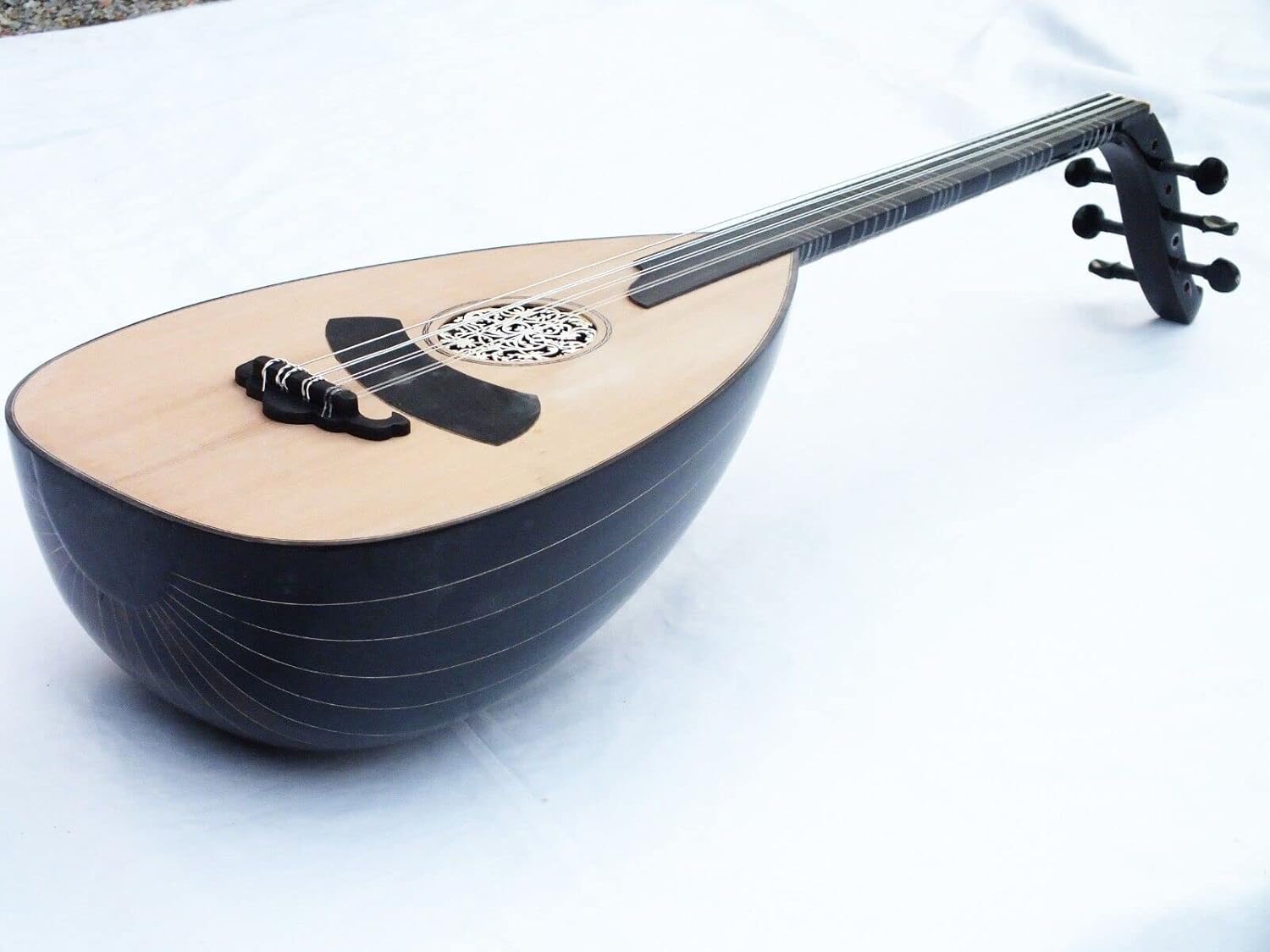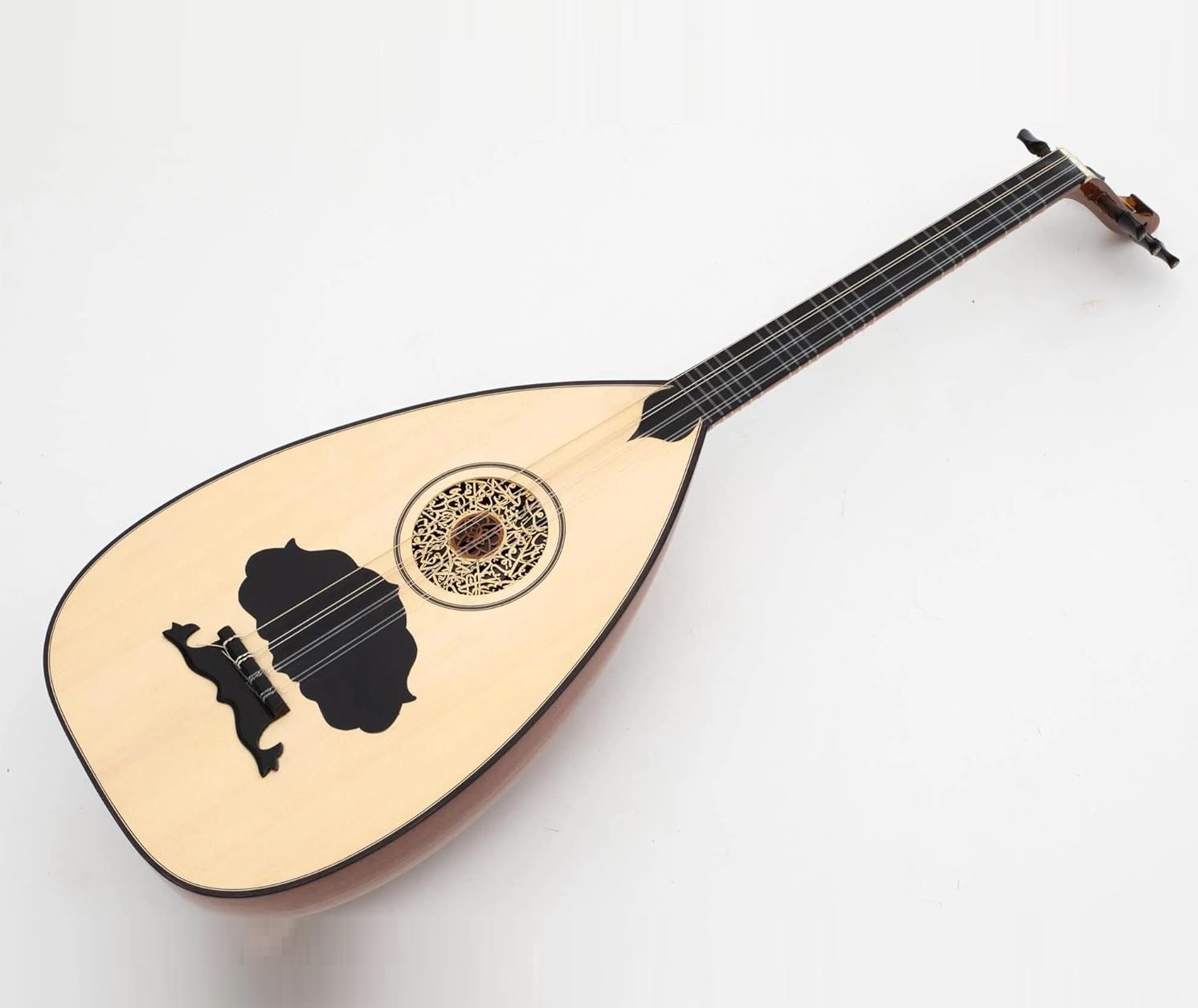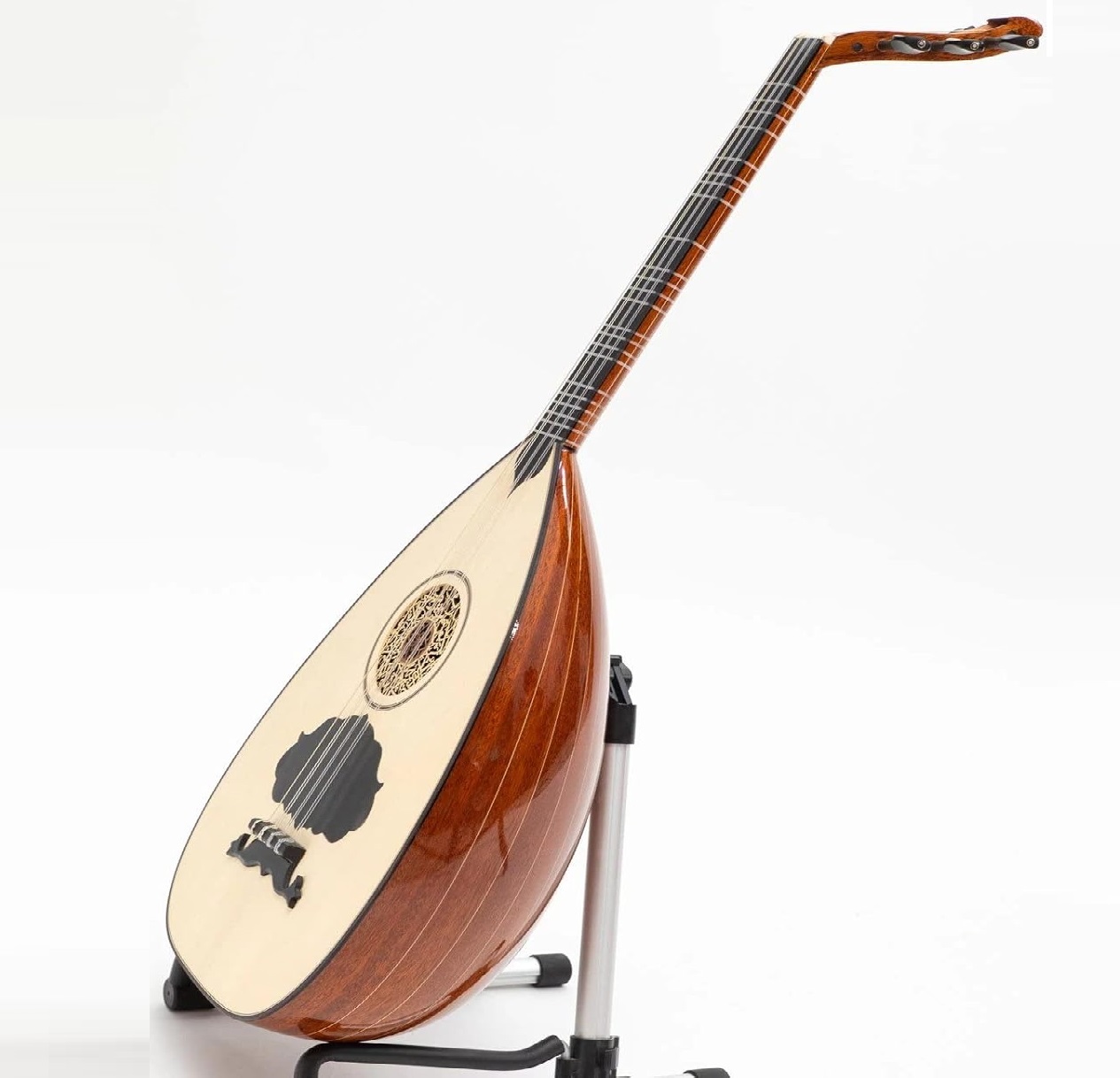Lavta
Plucked Instruments
Europe
Between 1001 and 1900 AD
Video
The lavta, a captivating stringed instrument, holds a significant place in the musical heritage of Eastern Europe and the broader Mediterranean region. Its unique sound and historical significance have cemented its position as a vital element in both folk and art music traditions.
Description and Type of Instrument
The lavta is a long-necked, fretted lute, typically played with a plectrum. It belongs to the broader family of lutes, a group of stringed instruments characterized by a rounded body, a neck with frets, and strings that are plucked or strummed. The lavta’s distinguishing features include its relatively shallow, pear-shaped body, its long neck, and its movable frets, which allow for a wide range of tonal possibilities. Its sound is often described as bright, clear, and resonant, capable of both delicate melodies and energetic rhythms. The instrument can be found in various sizes and tunings, contributing to its versatility across different musical genres.
Historical Background
The lavta’s history is deeply intertwined with the cultural exchanges that occurred throughout the Mediterranean and Eastern Europe. Its origins can be traced to the Byzantine Empire, where similar long-necked lutes were prevalent. The instrument’s development was influenced by the migration of various peoples, including the Romani, and the spread of Ottoman culture. The lavta’s presence in the Balkans, particularly in Greece and Turkey, became firmly established during the Ottoman era, spanning from the 14th to the early 20th centuries. During this period, the lavta became an integral part of both urban and rural musical traditions. In the 19th century, with the rise of urban musical styles in cities like Constantinople (now Istanbul) and Smyrna (now Izmir), the lavta experienced a resurgence in popularity, becoming a key instrument in the development of Rebetiko music. Rebetiko, a genre characterized by its melancholic melodies and social commentary, provided a platform for the lavta to showcase its expressive capabilities. The 20th century saw the lavta’s role evolve, with some musicians adapting it to contemporary musical styles while others maintained its traditional repertoire. Despite facing challenges from the introduction of newer instruments, the lavta continues to be cherished for its historical significance and unique sound.
Construction and Design
The construction of a lavta involves meticulous craftsmanship, utilizing a variety of materials and techniques. The body of the instrument, known as the soundbox, is typically made of thin strips of wood, such as maple, walnut, or spruce, glued together to form a rounded, pear-shaped shell. The top of the soundbox, or soundboard, is usually made of spruce, a wood known for its resonant qualities. The soundboard features a soundhole, which can be circular or oval, and is often decorated with intricate patterns. The neck of the lavta, which is typically made of hardwood, extends from the body and features frets that divide the fingerboard into specific intervals. These frets were traditionally made of gut or silk, but modern lavtas often use nylon or metal. The pegbox, located at the end of the neck, houses the tuning pegs, which are used to adjust the tension of the strings. The strings themselves were traditionally made of gut, but modern lavtas often use nylon or steel strings. The bridge, located on the soundboard, supports the strings and transmits their vibrations to the body of the instrument. The design of the lavta reflects a balance between functionality and aesthetics, with attention paid to both the quality of the sound and the visual appeal of the instrument. Decorations, such as inlays and carvings, are often incorporated into the design, adding to the lavta’s artistic value. The lavta’s shallow body compared to other lutes is a key factor in its unique sound, as it provides a brighter tone.
Types of Lavta
While the basic design of the lavta remains consistent, there are variations in size, tuning, and construction that distinguish different types of lavta. The most common type is the standard lavta, which is used in a wide range of musical genres. Variations include smaller lavtas, which are often used for solo performances or in smaller ensembles, and larger lavtas, which are used in larger ensembles or for specific musical styles. Regional variations also exist, reflecting the influence of local musical traditions and craftsmanship. For example, lavtas made in Greece may differ slightly in design and construction from those made in Turkey. Additionally, the tuning of the lavta can vary depending on the musical style and the preferences of the player. Some lavtas are tuned in fourths, while others are tuned in fifths or a combination of both. The number of strings can also vary, with some lavtas having six strings and others having eight or more. The types of strings used, gut, nylon, or steel, also create different tonal qualities. The lavta also has close relatives, such as the oud, which shares some similarities in design and construction but differs in its overall sound and playing style. The development of the lavta has been influenced by these related instruments, contributing to its diverse range of variations.
Characteristics
The lavta possesses a unique set of characteristics that distinguish it from other stringed instruments. Its sound is characterized by its brightness, clarity, and resonance, making it suitable for both melodic and rhythmic playing. The movable frets allow for a wide range of tonal possibilities, enabling the player to produce microtones and other subtle nuances. The lavta’s long neck and shallow body contribute to its distinctive sound, providing a balance between sustain and clarity. The instrument’s versatility allows it to be used in a variety of musical genres, from traditional folk music to contemporary compositions. The lavta’s role in Rebetiko music highlights its ability to express a wide range of emotions, from melancholy to joy. The instrument’s ability to blend with other instruments, such as the violin, clarinet, and percussion, makes it a valuable addition to ensembles. The lavta’s expressive capabilities are further enhanced by the use of different playing techniques, such as tremolo, slides, and ornaments. The use of a plectrum allows for a clear and precise articulation of notes, while the player’s fingerpicking can produce a more delicate and nuanced sound.
The lavta’s historical significance and cultural value have contributed to its enduring popularity, ensuring its continued presence in musical traditions across the Mediterranean and Eastern Europe. The instrument’s adaptability has allowed it to evolve and adapt to changing musical tastes, while still maintaining its core identity. The lavta’s intricate construction and design reflect the craftsmanship and artistry of its makers, contributing to its aesthetic appeal. The instrument’s ability to evoke a sense of history and tradition adds to its allure, making it a cherished part of musical heritage. The lavta’s bright tone allows for a wide range of musical expression, from lively folk dances to sorrowful laments. The instrument’s ability to produce both melodic and rhythmic passages makes it a versatile tool for musical expression. The lavta’s role as a key instrument in the development of Rebetiko music underscores its significance in the cultural history of the region. The instrument’s ability to connect with audiences on an emotional level contributes to its enduring appeal. The lavta’s continued presence in contemporary musical performances and recordings ensures its legacy for future generations.
Playing Techniques and Sound Modifications
The lavta, a plucked string instrument with a rich historical background, utilizes a variety of playing techniques to produce its unique sound. Primarily, it is played with a plectrum, allowing for clear and precise articulation of melodies. Different plectrum materials, such as tortoiseshell or modern synthetic materials, affect the tone, with harder materials producing a sharper sound and softer materials a mellower tone. The lavta’s fretboard facilitates a range of melodic possibilities, and musicians employ techniques such as slides, hammer-ons, and pull-offs to add ornamentation and expressiveness to their playing. Tremolo picking, involving rapid, repeated strokes, generates a sustained and shimmering effect. Players often use vibrato, a subtle oscillation of pitch, to add warmth and depth to sustained notes. Further sound modifications occur through the placement of the hand on the strings and the proximity of the plucking hand to the bridge or the soundhole. Plucking closer to the bridge creates a brighter, more metallic sound, while plucking closer to the soundhole produces a warmer, rounder tone. Muting techniques, achieved by resting the palm of the hand on the strings, allow for percussive effects and rhythmic variations. The instruments gut or nylon strings, also impact the overall sound. Gut strings, historically more common, produce a warmer, mellower sound, while nylon strings offer a brighter and more stable intonation. In the modern day some musicians have looked to modify the construction of the instrument, or the strings used, to try and achieve certain sonic goals.
Applications in Music
The lavta has found its place in various musical contexts, particularly in the classical music traditions of the Eastern Mediterranean and the Ottoman Empire. Historically, it played a significant role in fasıl music, a genre of Ottoman classical music characterized by its suites of instrumental and vocal pieces. In these ensembles, the lavta provided melodic and harmonic support, contributing to the rich and intricate textures of the music. It also found use in more intimate settings, accompanying vocal performances and solo instrumental pieces. Beyond classical music, the lavta has also been incorporated into folk music traditions, where its versatility and expressive capabilities have made it a valuable instrument for a variety of musical styles. In contemporary music, the lavta is experiencing a revival, with musicians exploring its potential in diverse genres such as world music, jazz, and experimental music. Its unique sound, combining elements of plucked lutes and guitars, has captivated modern audiences and composers. The instrument’s capabilities allows it to be used in harmonic roles, as well as lead melodic roles. This versatility has led to its inclusion in many different musical ensembles throughout its history, and into the present day.
Most Influential Players
Throughout its history, the lavta has been championed by numerous influential players who have shaped its repertoire and playing techniques. These musicians, often associated with the Ottoman court and musical salons of Istanbul, were masters of their craft, pushing the boundaries of the instrument’s capabilities and leaving a lasting legacy. Notable figures include Tanburi Cemil Bey, whose virtuosity and innovative approach to improvisation set a new standard for lavta playing. His recordings, preserved on early gramophone records, continue to inspire musicians today. Other influential players contributed to the development of specific playing techniques, compositions, and pedagogical methods. The legacy of these players can be found in the methods that modern day lavta players use. There has been a continual passing down of information from one generation to the next, helping keep the lavta’s traditions alive. In the modern era, there are musicians who are actively reintroducing the lavta to the world, and by creating new music, help solidify the lavta’s place in modern music.
Maintenance and Care
Maintaining the lavta’s optimal condition requires consistent care and attention to detail. Like any stringed instrument, the lavta is susceptible to environmental changes, particularly fluctuations in temperature and humidity, which can affect its tuning, structural integrity, and sound quality. It is essential to store the instrument in a stable environment, away from direct sunlight, extreme heat, or excessive moisture. Regular cleaning of the strings and body is crucial to prevent the buildup of dust, dirt, and oils, which can dull the sound and damage the instrument’s finish. Proper tuning is essential for achieving accurate intonation, and musicians should use a reliable tuner to ensure that the instrument is in tune before each performance. String changes should be performed with care, and only high-quality strings should be used. When not in use, the lavta should be stored in a protective case to prevent accidental damage. Periodical inspections of the instrument are recommended to identify any potential issues, such as loose tuning pegs, cracks, or warping. If professional repairs are needed, it is important to seek out a luthier experienced in working with historical stringed instruments.
Cultural Significance
The lavta holds deep cultural significance, particularly in the regions associated with the Ottoman Empire. It stands as a testament to the rich musical heritage of this era, reflecting the complex interplay of cultural influences that shaped Ottoman music. The instrument’s association with the Ottoman court and musical salons imbued it with an aura of refinement and artistic sophistication. It was considered an important component of classical ottoman music. In modern day Turkey, and other areas that were part of the Ottoman Empire, the lavta is often viewed as a symbol of cultural identity and historical continuity.
Revivals of interest in Ottoman music and culture have helped rekindle the lavta’s popularity and ensure its continued transmission to future generations. The instrument’s distinctive sound and visual aesthetic evoke a sense of nostalgia for a bygone era, connecting listeners to the rich tapestry of Ottoman musical traditions. The lavta represents more than just a musical instrument; it encapsulates the cultural memory and artistic expression of a civilization. The dedication that musicians and researchers have towards keeping the lavta and its music alive, is a testament to its cultural importance.
FAQ
What are the main features of the Lavta?
The Lavta is a small, fretted lute with a pear-shaped body, wooden soundboard, and tied gut frets. It has a floating bridge, six or seven nylon or gut strings, and produces a delicate, warm tone. The instrument is primarily used in Turkish and Greek music.
How is the Lavta constructed?
The Lavta is crafted with a wooden bowl-shaped body made from mulberry, walnut, or mahogany. Its soundboard is typically spruce, and the neck is fitted with movable gut frets. The instrument features a floating bridge and friction pegs for tuning.
What are the primary uses of the Lavta?
The Lavta is traditionally played in Ottoman classical music and Greek rebetiko. It is used as both a solo and ensemble instrument, providing melodic and harmonic accompaniment. Today, it is also explored in fusion genres and experimental music.
 Links
Links
References
Other Instrument
Categories




















